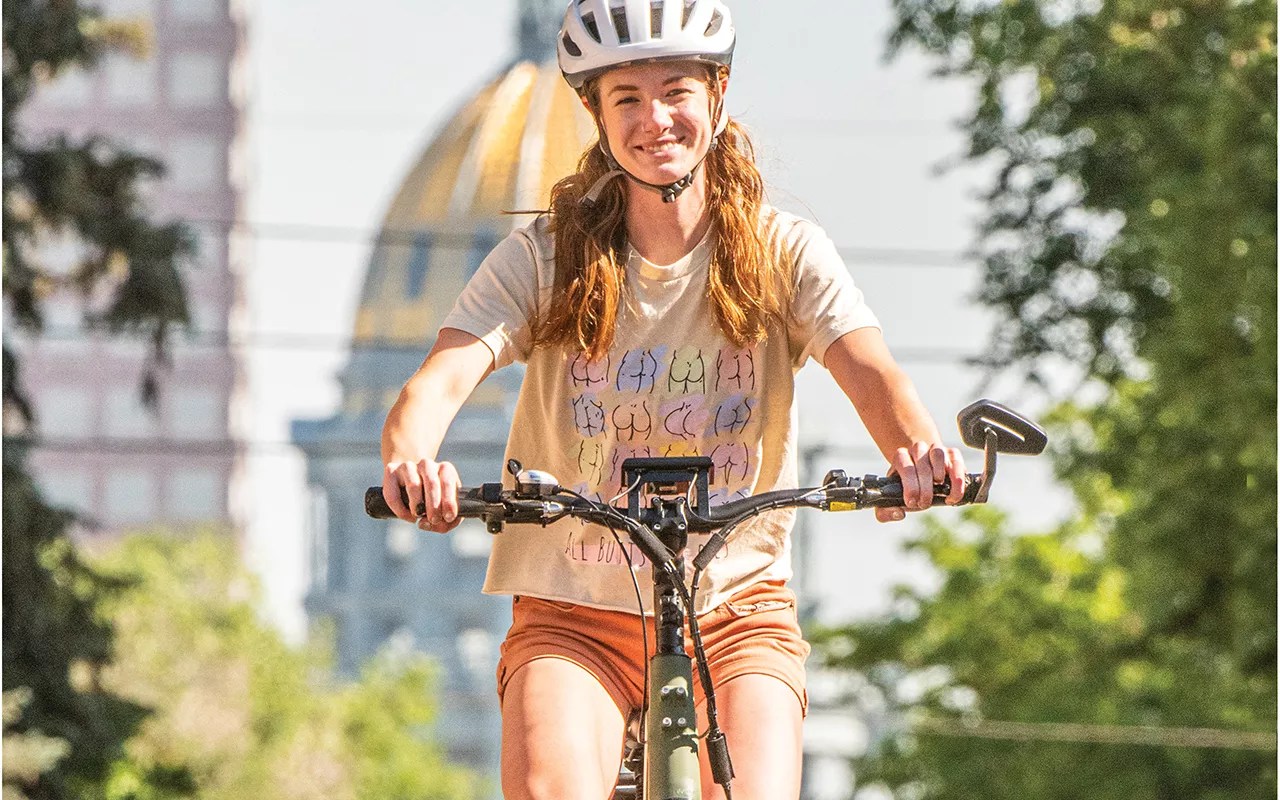
Evan Semón

Audio By Carbonatix
The first time I hopped on an e-bike, I felt like I was breaking some unwritten rule about biking. But I was late for a Rockies game and needed all the help I could get – even if it came from an electric motor. By the time I arrived at Coors Field – no beads of sweat on my forehead, breathing just fine in the mile-high air – I was hooked.
So when the City of Denver launched an e-bike rebate program on Earth Day, it seemed like a sign from the bike gods that it was time to pivot away from paying for Lyft and Lime e-bikes and get my own.
The rebates were offered in a few tiers: Any resident could qualify for $400, and people with more limited incomes could get a $1,200 rebate. For those interested in cargo e-bikes, which have storage capacity that can handle even Costco runs, an additional $500 was available.
I wasn’t alone in applying for a rebate. News spread quickly after the Denver Office of Climate Action, Sustainability and Resiliency announced the project. By May 11, CASR had stopped accepting applications because it had already received 3,250 for a three-year program budgeted at $3 million for the first year.
Denver, make your New Year’s Resolution Count!
We’re $10,000 away from reaching our $50,000 year-end fundraising goal. Your support could be what pushes us over the top. If our work has kept you informed and connected this year, please consider making a contribution today.
“We definitely anticipated some interest, but I think there was much more than we thought we would see,” says Winna MacLaren, CASR’s manager of communication and engagement. “Funny enough, it was supposed to be a soft launch.”
But since fewer than 1,000 of those rebates have been paid out so far (they’re only good for two months), CASR will again accept applications starting July 11, with 2,000 available.
The city is on a roll.
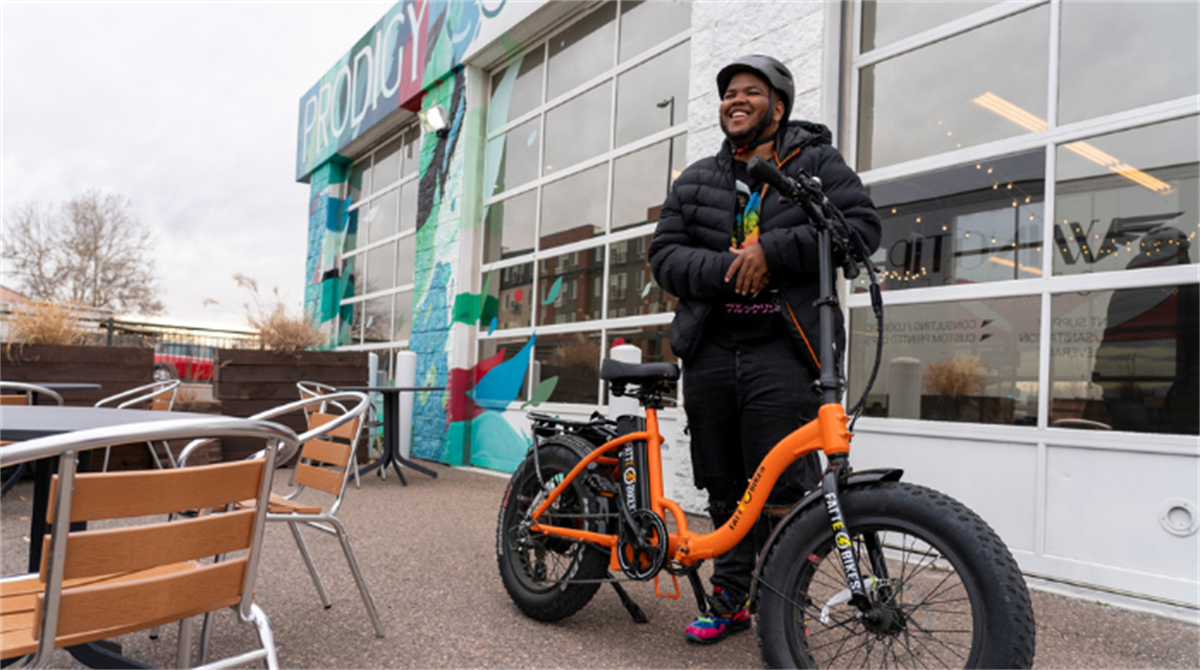
The Denver Office of Climate Action, Sustainability and Resiliency introduced its e-bike rebate program in April.
CASR
On July 1, 2020, the Office of Climate Action, Sustainability and Resiliency was chartered; the new city department designed to help fight climate change had been pushed by both Mayor Michael Hancock‘s administration and Denver City Council. In November 2020, Denver voters approved a .25 percent sales tax increase that would generate up to $40 million a year to fund the new office starting in 2021.
This climate protection fund was earmarked for programs in a handful of categories: energy-efficient buildings and homes, adaptation and resilience, environmental justice, renewable energy, workforce development and sustainable transportation.
E-bikes fill the bill in a couple of areas.
E-bikes have been around in some form since the late nineteenth century but have really grown in popularity over the past three decades. In 2009, Colorado became one of the first states to define and legalize e-bikes. And then in 2017, the state further refined its classification system, which affects where e-bikes can be used.
The bikes range in price from around a thousand dollars to ten times that. But they all share a basic defining element: an electric motor. “They exist to make riding a bike easier,” notes Aishwarya Krishnamoorthy, director of marketing and communications at Bicycle Colorado.
E-bikes come in three classes. Class I is a pedal-assist bike, with a motor that kicks in when the biker is pedaling. Class II is a throttle-assist bike, which allows a biker to move forward without pedaling by using the throttle. Both of these classes have top speeds of 20 miles per hour. A Class III e-bike can go up to 28 miles per hour, whether the rider is using the throttle, pedal or both. Class I and II e-bikes are allowed anywhere a regular bike is in Denver, while there are more restrictions on Class III e-bikes.
As CASR considered how it could encourage the use of e-bikes to reduce car trips, helping reduce an individual’s carbon footprint and also making roads less congested, it looked to a pilot program launched by the state two years ago. In 2020, the Colorado Energy Office and Bicycle Colorado had provided Class I e-bikes to thirteen low-income essential workers.
“The e-bike became the dominant commute mode share,” recalls Krishnamoorthy. “Thirty-one percent of commutes then were taken by e-bikes, compared to other modes. There’s a significant emission impact, and the people loved it.”
Building off this small model, CASR decided to create a three-year, $9 million program that would provide rebates not only for e-bikes, but also for heat pumps and other energy-saving equipment for Denver homes, including electric-vehicle charging stations.
The three-year duration “was a recommendation from our city attorney’s office as a standard best practice,” MacLaren says. “We contract with a rebate administrator to process the rebates. It’s good to evaluate contracts after two or three years and decide to either renew with a vendor or see what other opportunities are available with other vendors, or new vendors.”
But first the city needed to let Denver residents know that the rebates were available.
“Really, what we’re looking for right now is a market transformation.”
“Really, what we’re looking for right now is a market transformation. If you look at sort of how people make changes, behavior changes, one of the ways to do that is to give them a nudge,” says MacLaren.
The nudge worked.
As of June 29, 863 e-bike rebates had been redeemed for $716,156 worth of rebates on more than $2 million in e-bike purchases.
Denver has a list of participating bike shops in the metro area where people can purchase e-bikes using the rebate, which comes off the final price, whether it’s $1,000 or $10,000.
CASR was particularly pleased with the high number of applications for the larger, income-based rebate. To qualify, applicants must show that they’re enrolled in some type of welfare assistance, like food stamps, or that they have a household income below 80 percent of the area median income. Eighty percent of the area median income in Denver is $62,600 for a one-person household and $71,550 for a two-person household.
So far, 56 percent of the money covering the rebates has gone to bikes purchased by lower-income individuals.
“We’re very intentional about building that at least 50 percent of the funds had to go to front-line and low-income communities,” says Denver City Councilmember Jolon Clark, pointing to the specific standards CASR has to follow using climate-protection funds.
Purchasers are certainly using them for more than recreation. “About 60 percent of car trips are six miles or less, and 45.6 percent are three miles or less, which is pretty easily traversable,” says Krishnamoorthy. “It costs pennies on the dollar to charge an e-bike.”
“It’s clear that there’s demand and desire and that people are open and willing to try e-bikes. Sometimes people just need that nudge, whatever it might be,” MacLaren says.

Emily Kleinfelter bought an e-bike from local company FattE-Bikes.
Evan Semón
For Robbie Hobein, the basic rebate coupled with the e-cargo bike rebate was nudge enough.
“Cars are so expensive to buy, operate and maintain. If we can get more folks into e-bikes, that’s more money in their pocket that they can use for whatever they need. And it’s a win for the environment,” says Hobein, a resident of Curtis Park who is in her fifties.
“Two important things for me were, could I easily lift this up and is the shop local? Could I walk my bike to it?” Hobein recalls. She found the perfect option at BikeSource in RiNo.
Using rebates, Hobein knocked $900 off a $4,000 e-cargo bike. She sold her pickup truck to fund the rest of the purchase.
“I’ve ridden it everywhere I’ve wanted to go,” says Hobein, a self-professed “bike nut” who appreciates the addition of the motor. “It’s nice if you’re on an e-bike, because it’s not quite as much work.”
She doesn’t need to worry about parking, she points out, and the cargo components allow her to make extra-large hauls from the grocery store.
The e-bike that Emily Kleinfelter bought from FattE-Bikes, a local shop that makes its own e-bikes, allows her to commute to and from work at the same speed as cars traveling in the morning and later afternoon.
“I do tend to use the throttle or the turbo speed so I can keep up with the speed of traffic and just not give cars any reason to get annoyed with me for one reason or another,” says Kleinfelter, who considers herself a “very defensive” bike rider. After applying the $400 rebate, Kleinfelter bought her bike for close to $2,000
.
A 27-year-old who works as the safety and regional Vision Zero planner for the Denver Regional Council of Governments, looking at ways to cut down on traffic deaths, Kleinfelter says that the rebate program persuaded her to buy an e-bike. “It’s nice to have when I’ve had to ride into the office in nicer attire and don’t want to get sweaty,” she says.
The throttle assist of her FattE-Bike is so powerful, she doesn’t even need to pedal. “I feel like I’m cheating, and I don’t like saying that,” Kleinfelter admits. “I have to keep reminding myself it’s okay, I’m not using it as my adventure bike. I’m using it as a car replacement.”
“I have to keep reminding myself it’s okay, I’m not using it as my adventure bike.”
To get in her exercise, she often rides her non-e-bike.
For Luchia Brown, a 55-year-old who works from home, an e-bike purchase just started to make sense when she started thinking about extra-long rides. “I wanted a bike that I’d be able to ride comfortably for good distances, replacing car trips that I might take,” Brown says. Using a $400 rebate, she bought a beach cruiser-style e-bike for close to $3,000.
“It brings me so much joy,” she says. “I have been thinking about it for a long time.”
With my journalist’s salary, I qualified for an income-based rebate. Within days of applying, I received an email that my application had been accepted and that I would be getting a rebate of $1,200 off a regular e-bike or $1,700 off a cargo e-bike. Weeks later, I received an “audit” email from a CASR staffer, asking me to verify my income, which I was able to do by sending over a tax return.
In between, I spent sleepless nights trying to decide what to do. Should I get a fancier e-bike with a throttle, or a more traditional pedal-assist e-bike? I looked at a FattE-Bike, like the one Kleinfelter purchased, as well as an REI e-bike.
While a few hundred dollars more expensive, the FattE-Bike was superior to the REI bike in a number of ways: It’s locally made, fully customizable and an absolute beast. Since it’s a Class II e-bike, I could ride around town just using the throttle, without pedaling. I took it out for a spin on the streets of Sun Valley near the store and loved it.
The REI bike – a Co-op Cycles CTY e2.1 Electric Bike – was a pedal-assist model and much cheaper. It could also be ready in under two weeks, which compared favorably to the four to eight weeks that it would take for a FattE-Bike to be ready.
I tested the REI bike, too, heading from the flagship store down the South Platte River trail. I loved that one, too.
And then I slept on the decision. And slept. And slept some more.
I ended up going with the REI bike for three reasons: It would be ready sooner, it was cheaper, and it would also require me to do at least some exercise. As a healthy thirty-year-old, I didn’t want to become lazy by relying on my throttle assist. I didn’t want to be “cheating,” as Kleinfelter put it.
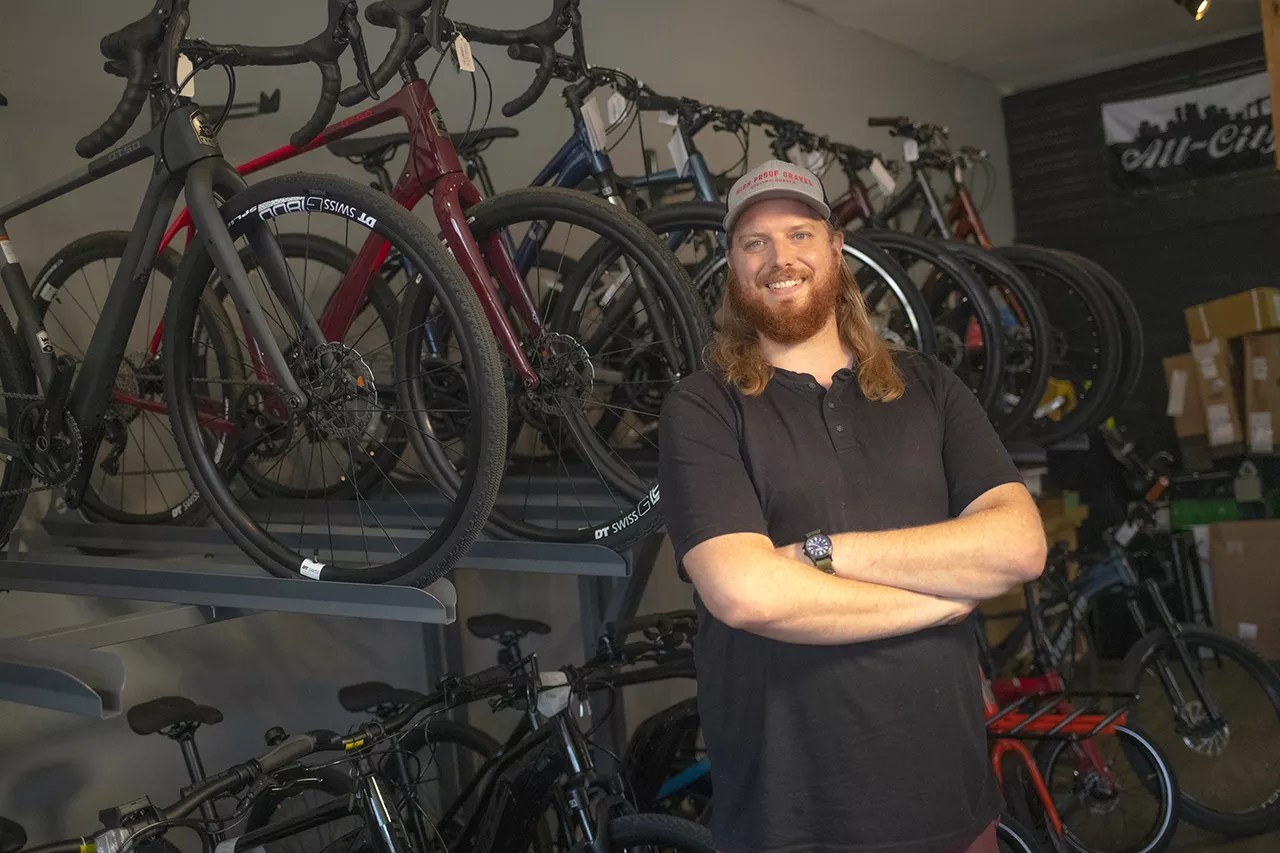
Bobby Brown and SloHi Bike Co. have been loving the rebate program.
Evan Semón
The e-bike rebate program has been a hit with retailers as well as Denver residents.
“We basically sold about four times as many e-bikes and about two times as many cargo e-bikes,” says Bobby Brown, the marketing manager for SloHi Bike Co., comparing sales during the rebate period to the same time last year.
Since e-bikes can be expensive, SloHi, which has stores in City Park and Highland, started stocking a new brand, the SWFT Fleet, in order to offer a lower-cost option to those with the low-income rebates.
“We gave a lot of people basically a free e-bike through the rebate program,” Brown notes. After taxes were added and the $1,200 rebate subtracted, the SWFT Fleet wound up costing just about $88 for those who qualified.
Kenny Fischer, who co-founded FattE-Bikes back in 2017, says that his store has sold about a hundred bikes because of the rebate. “The neatest thing that we’ve seen is that the demographic is very different than what we’ve seen for a typical e-bike purchase,” Fischer says.
Before the rebate program, the typical e-bike purchasers had been Baby Boomers. Now the demographics of FattE-Bikes customers have dropped by 25 to 30 years, he says, particularly as families come in with the goal of transitioning away from cars. “Younger people are coming in definitely looking for a way to save some money,” he adds.
Fischer likes to highlight the fact that FattE-Bikes is “Denver’s first locally born electric bike company.”
Before forming it with his wife and business partner, Victoria Brunner, Fischer had produced an upcycle festival called PalletFest.
“One day my car broke down, and we realized we still needed a second vehicle for our household but didn’t want to spend a ton of money on another car. Gas is expensive, as is insurance and upkeep. Plus, traffic sucks, and we wanted to avoid it in any way possible,” says Fischer. “That’s when Victoria discovered the electric bike, and I knew right away e-bikes would be the next big thing, but also not a fad. They’re all the fun of a bike but with the functionality of a vehicle.”
He and Brunner started FattE-Bikes with the goal of bringing a better product to the market. But they faced challenges from the start, aggravated by supply-chain slowdowns over the past two years.
“Bikes are primarily comprised of aluminum and rubber. We have a massive shortage of those two products as well,” says MacKenzie Hardt, owner of Hardt Family Cyclery in Aurora, a store participating in the e-bike rebate program. When those shortages are combined with “fuel shortages, truck shortages, cargo container shortages, labor shortages in the port…items that used to take four to six months are taking two to three years to get in,” Hardt adds.
“We’ve seen a massive spike in sales within a massive downturn in supply.”
And this all came at a time when people were buying more e-bikes, with a goal of not just saving money and helping the environment, but simply getting outside during the pandemic. “We’ve seen a massive spike in sales within a massive downturn in supply,” Hardt says.
The supply-chain issues have gotten a bit better recently, he notes. And in order to keep up with the rebate-inspired demand, his store, like SloHi, has been stocking up when it can.
Since FattE-Bikes makes its own bikes, Fischer has been ordering parts months in advance so that it can guarantee that a custom-made bike will only take a month, two at the most. Even so, he’s had to scramble.
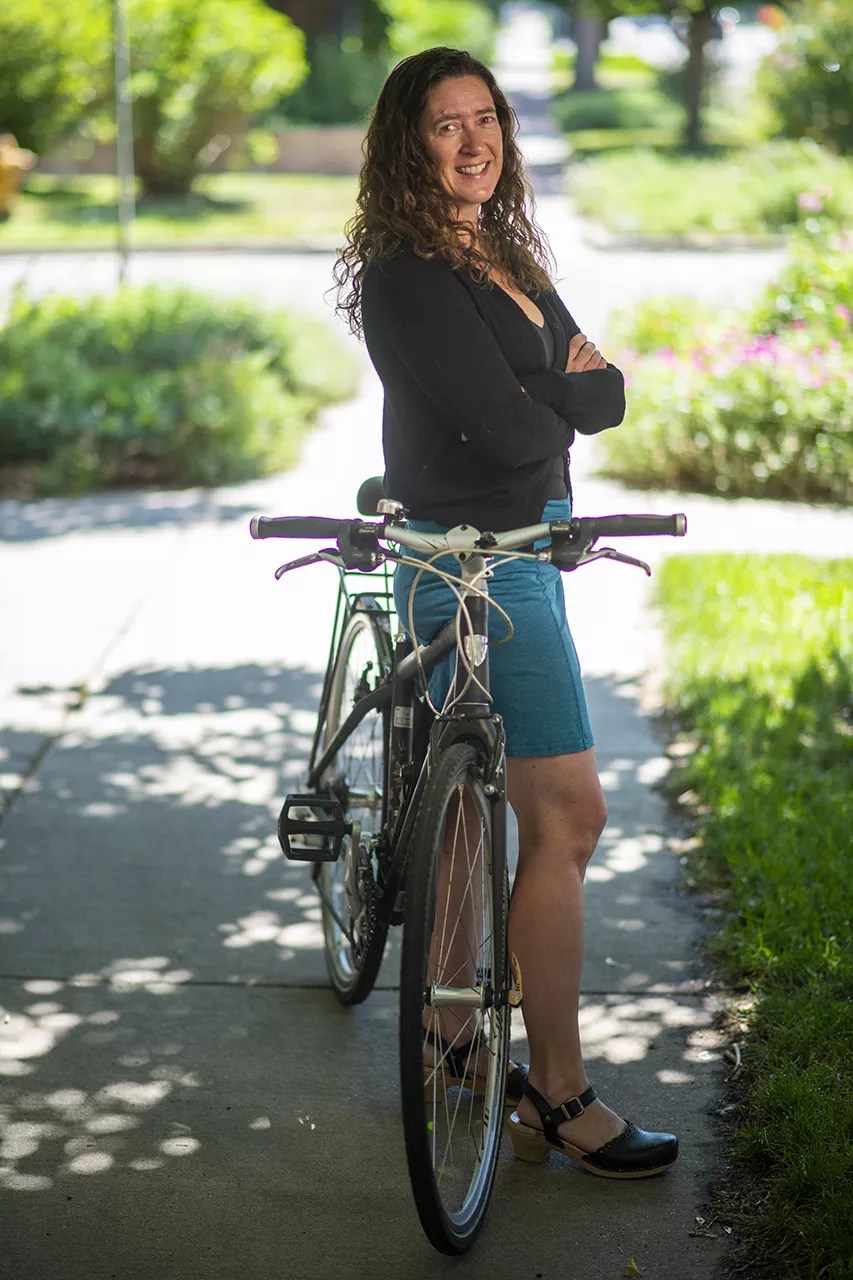
Jill Locantore wants Denver to improve its bike infrastructure.
Evan Semón
There’s not just competition to get bikes. There’s competition over where to ride them.
The Cherry Creek Trail, which runs through multiple counties, is the crown jewel of the metro Denver bike infrastructure. The Highline Canal Trail, the Platte River Greenway and the Bear Creek Trail are three more popular paths in the area. Some bike purists don’t appreciate seeing e-bikes on these trails, which they’re already sharing with walkers, hikers, rollerbladers and sometimes even horses.
“I’ve noticed that a lot of e-bikers do not call out their pass. And some of the e-bikes, depending on the size of their tires, are whisper-quiet – you can’t even hear them coming,” says Alton Dillard, a member of the Major Taylor Cycling Club of Denver. “There have been a few times where you’ve been buzzed by somebody on an e-bike, especially in the narrows as you’re coming into downtown Denver through Confluence Park. We want people just to make sure they’re being safe.”
For Krishnamoorthy, the problem comes down to the individual user. “It’s more about the person using the bike,” she says. “If you’re using the trail correctly and leaving the space for other people, it’s not going to be as damaging. I think pitting bike users against each other won’t result in anything useful, but going to the heart of the problem is that there isn’t enough space because there’s an imbalance in the use of space.”
“Where the tension comes is exactly what I was just talking about, where you don’t have enough space, where everybody is trying to use it,” says Jill Locantore, executive director of the Denver Streets Partnership. “We’ve dedicated so much of our public right-of-way for cars and people driving, and we’ve just left scraps for everybody else to be fighting over.”
While the trails are great for exercise and sometimes even commuting, Denver doesn’t have a truly connected bike path system through the city.
In 2018, the City of Denver set a goal of building 125 new miles of bike lanes by 2023. So far, it has built 103 miles.
“They’re doing pretty good in terms of funding and mileage. We’ve definitely seen increases over the years of the city regularly allocating money in the annual budget for the buildout of the bike network and an increase in the mileage of it,” says Locantore. “I think the biggest challenge is the quality of what they’re building, and it’s not quite keeping pace with the community in raising the bar in terms of what they’re expecting from a bike facility. People are now really calling for more high-comfort facilities. There’s been some frustration in the bike advocacy community in what the city is building.”
“There’s been some frustration in the bike advocacy community in what the city is building.”
An example of a high-comfort facility is a bike lane that runs along a street and has an actual cement barrier between the lane and the cars in the street.
In determining whether to build a protected bike lane or simply stripe a street with paint to designate a bike lane, the Denver Department of Transportation and Infrastructure relies on “data associated with how many vehicles are using the corridor as well as the speed along the corridor,” according to Emily Gloeckner, Denver’s traffic engineer and director of transportation design.
“If we start to see upwards of 7,000 vehicles a day using this street, that says to us that we need protection for this bike lane in order to provide that high-comfort facility. It’s a case-by-case type of implementation,” Gloeckner says.
Colleague Jennifer Hillhouse, Denver’s director of transportation and mobility planning, notes that there are “tradeoffs” and that “protection requires more space.”
“Our standards are based on the value that all ages and abilities are willing to ride a bike. We’re designing for children, we’re designing for elderly,” Hillhouse says.
But biking advocates like Locantore want the city to take more radical action – fast.
“For decades, we’ve been solely focusing on making driving safe, easy and convenient. They have to be willing to start making these tradeoffs, they have to be willing to start doing things like adding more frequent diverters to neighborhood streets. They have to be willing to remove on-street parking,” Locantore says.
And the city may have to be willing to spend even more money on bike infrastructure.
“We are committed to building out our network. A lot of it is funding-constrained. The more funding we have, the more opportunity we have to accelerate the buildout of our network. It is a commitment that we have, and we intend to continue to build out. The amount of time will just depend on the funding,” says Gloeckner.
“There are grandiose plans for protected lanes and different lanes, and they get watered down,” e-bike rider Brown complains. “It’s usually local neighbors whining about parking. We’ve gone from protected bike lanes to neighborhood bikeways. Just paint on the street is not going to get it done.”
Bike advocates are now making their wants known to officials working on Denver Moves Everyone, a plan that will guide transportation in the city from 2023, when the guideline is slated to be adopted, through 2050.
“Denver Moves Everyone will build a road map and six-year capital plan that will be focused on not only where the investments are needed, but will also be outcome-based,” says Gloeckner. “We have to be very strategic and thoughtful about where these dollars are spent to have the biggest impact.”
E-bike dollars are having a big impact on Denver right now.

Applicartions will be accepted again on July 11.
CASR
“Denver is really on fire, and they’re doing a wonderful job with the rebate programs,” says Lance Camisasca, who is organizing (e)revolution, a national e-bike trade show, at the Colorado Convention Center in June 2023. Camisasca and his partners chose Denver for the event because of its central location and “vibrant cycling community”; the show will be geared toward retailers, manufacturers and consumers.
“Denver is the right place at the right time,” Camisasca says.
And the rebate program is the right tactic to keep things rolling, according to CASR.
“We really do need to give the program a good number of months to play out to see how people are using the e-bikes. How does this lower greenhouse gas emissions?” MacLaren says. “The extent to which we are going to do it, we are hopeful.”
CASR celebrated its two-year anniversary on July 1. The day before, the office released its 2021 annual report to highlight some of the work it had done around Denver. In particular, the office led the charge on reducing buildings’ reliance on fossil fuels, helped implement a policy to reduce the use of plastic bags at grocery stores and convenience stores, and implemented a policy to reduce the use of single-use items from delivery orders and drive-thrus.
“The global climate crisis is contributing to Denver’s longer and more frequent droughts, hotter temperatures and poor air quality, among other hazards. Scientists and experts agree that wealthier nations and cities must act swiftly to curb further greenhouse gas emissions that contribute to climate change and support adaptation and resilience for those most vulnerable to address the impacts we are already experiencing today,” MacLaren notes in a statement attached to the 2021 annual report.
As part of CASR’s goal of getting Denver to net zero for carbon emissions by 2040, the office also earmarked $18 million for community solar energy projects. And CASR funded workforce development for under-resourced residents of Denver, planted over 2,000 trees to increase the tree canopies in climate-vulnerable neighborhoods, and helped pay for a free, on-demand micro-shuttle for residents in Montbello.
And then there was the e-bike rebate program, which has a parallel state program.
This past legislative session, Colorado lawmakers approved Senate Bill 193, titled “Air Quality Improvement Investments.” Senator Julie Gonzales, a Democrat who represents north, west and downtown Denver, served as a prime sponsor on that bill, which earmarks $12 million for a statewide e-bike program. “We know that a lot of Coloradans want to make this transition. We know that if we can help folks understand how to be less car-reliant in order to get from one place in town to another, we can really have a big impact and reduce the impact to air quality, and help folks make that climate transition as well,” Gonzales says.
The money will go toward traditional e-bike rebate programs statewide, like the one in Denver, and also toward local governments and nonprofits so they can set up e-bike share programs.
Although Gonzales didn’t know about Denver’s planned e-bike rebate program when she was working on SB-193, she says she’s thoroughly impressed with the program and plans to land a rebate when it restarts on July 11. In the meantime, the state senator will be testing out e-bikes in stores around Denver.
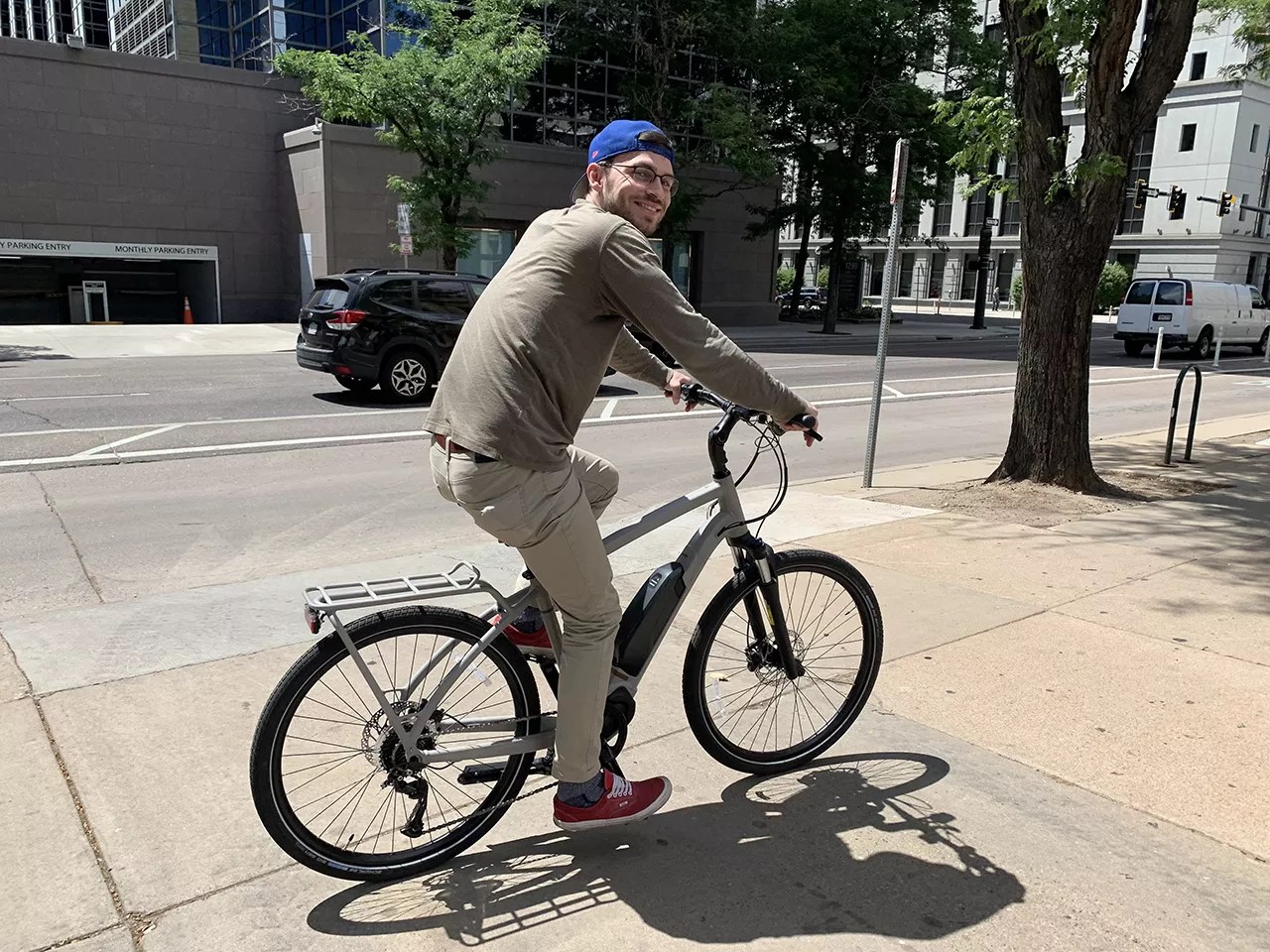
Me and my new e-bike.
Thomas Mitchell
But I no longer need to share. On June 30, I got an email from REI: My e-bike was ready. I quickly headed over to Confluence Park to pick up my brand-new e-bike that store staffers had put together.
And then I hopped on the Platte River Greenway, feeling like the fastest kid in my gym class. I arrived back at the office without a single bead of sweat on my forehead, breathing just fine in the mile-high air.
I’m hooked.